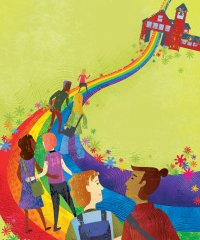Supporting LGBTQ Students in Elementary School
Three strategies elementary school teachers can use to foster a sense of inclusion for lesbian, gay, bisexual, transgender, and queer students.
Your content has been saved!
Go to My Saved Content.“Paul, do you have a girlfriend?” Parker asked me.
“I don’t,” I replied succinctly, hoping to avoid the topic altogether.
“Why?” she queried.
“Because I don’t want one,” I said.
“Why?” she asked again, smiling up at me.
It was clear I wasn’t getting out of this one. This first grader had questions—and would demand answers.
“Because I have a boyfriend,” I finally exhaled.
“Oh, that’s weird,” she said.
“I understand. Sometimes when things are different, they seem a little weird,” I replied. “Why do you think it’s weird?”
“Well, I just don’t like when people make fun of you. I feel bad for you.”
In these few minutes, it seemed as though my heart was broken and put back together all at once.
We adults often think of sexuality and gender as things that are out of reach for students—especially our youngest ones. We project our discomfort on them, assuming that discussing sexuality, biological sex, or gender is inappropriate for young students. But it’s clear from conversations like the one I had with Parker that children come into our classrooms with a wealth of knowledge.
One of our jobs as educators is to welcome students’ perspectives into the classroom. But we can also dismantle ways of thinking that reinforce the gender dichotomy and heteronormativity, and we must create safe spaces for children to explore their identities and empathize with those who are different from them.
In 2017, the CDC estimated that 8 percent of high school students identify as lesbian, gay, bisexual, transgender, or queer (LGBTQ). Kevin Jennings, founder of the Gay, Lesbian, and Straight Education Network, estimates that one in 10 educators in the United States identifies as LGBTQ. These data provide the moral imperative for showing pride in the classroom—for finding ways to include the LGBTQ community in our curriculum. The problem is that most teachers don’t know where to start, even in spaces where the LGBTQ community is already welcomed and visible.
3 Ways to Create an LGBTQ-Inclusive Classroom
1. Include LGBTQ children’s literature in your class library: As educators, we should provide both windows and mirrors in our curriculum, ensuring that our book selection represents a diverse array of people and identities. This includes the LGBTQ community. While you may not know it yet—especially if you teach young children—there are students who will identify as LGBTQ at some point in their lives. Our job is to provide a safe space and role models for them as they age.
This also means that we must represent the intersectionality that exists in the LGBTQ community, sharing stories of different genders, ethnicities, races, religions, and classes.
Here are a few of my book recommendations, which are mostly for grades K to 5:
- All Are Welcome by Alexandra Penfold and Suzanne Kaufman
- Julián Is a Mermaid by Jessica Love
- Pride: The Story of Harvey Milk and the Rainbow Flag by Rob Sanders
- Queer Heroes: Meet 52 LGBTQ Heroes From the Past and Present by Arabelle Sicardi
- Pink Is for Boys by Robb Pearlman
- A Family Is a Family Is a Family by Sara O’Leary
- George by Alex Gino
- The Boy and the Bindi by Vivek Shraya
2. Rethink practices that reinforce the gender dichotomy: Gender is constructed through intergenerational experiences and social norms. Once we’re aware of this, we can deconstruct the gender dichotomy and rebuild it as a fluid spectrum.
There are some simple ways to do this. Start saying, “Good morning, everyone!” instead of, “Good morning, boys and girls!” Have critical conversations with your kids about the many assumptions we make based on gender, providing counterexamples, like boys who like to sing or girls who play sports.
I’ve even written gender out of the stories I write with my class. In one instance, I was writing a fairy tale adaptation of Cinderella, modeling for my class.
“Is it a boy or a girl?” one student queried.
“Maybe we don’t need to assign our character a gender,” I replied, using the pronoun their deliberately throughout.
3. Capitalize on teachable moments: My experience with Parker didn’t happen because I planned it. It happened because Parker wanted to know me better—she wanted to find out about a part of my personal life. Over the course of her rather short life, Parker had learned that lots of adults have special people in their lives, and when those people aren’t husbands or wives, they are often boyfriends or girlfriends. To her, it seemed only natural to ask.
I could have shied away from the conversation, as I intended to do at the outset. In hindsight, I’m glad I took the teachable moment by the horns.
If you’re an LGBTQ educator like me, embracing these moments allows us to share a piece of ourselves that can provide either a window or a mirror into a whole set of stories to which most of our children have not been exposed. If you’re not, such moments provide you an opportunity to demonstrate how to be an ally for the LGBTQ community.
It’s scary, I know. For so many of us, this is uncharted territory. But to ignore these moments would be to operate in opposition to justice. To quiet students’ voices would mean crushing autonomy, courage, and vulnerability. And as educators, we cannot and must not do that.
We have a responsibility, you see. And as we enter into Pride Month, I hope it’s one that you don’t take lightly.
